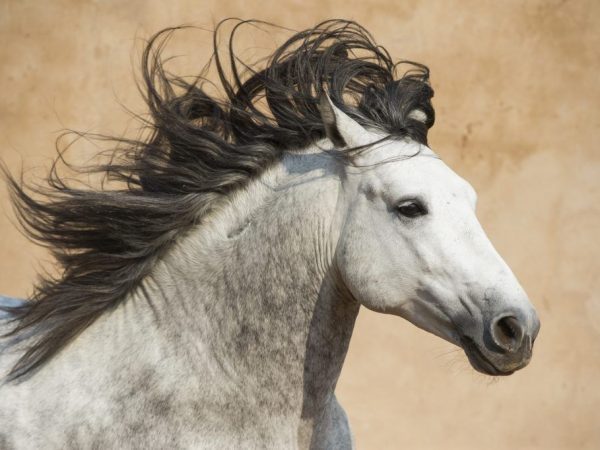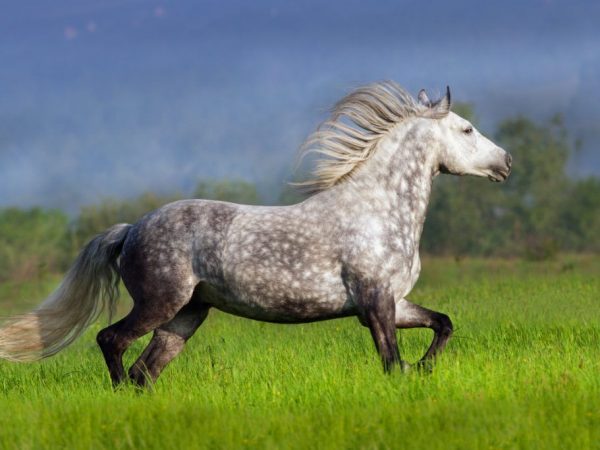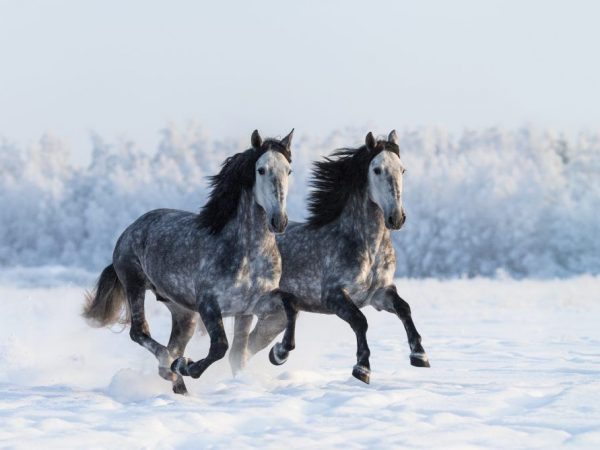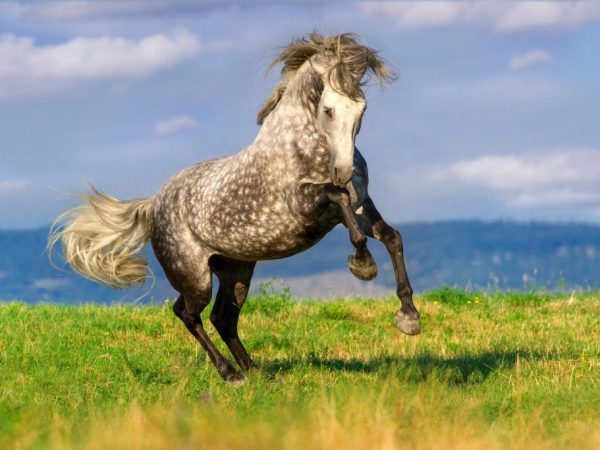Features of the Andalusian horse
The Andalusian horse was brought to the Russian Federation from the distant sultry Andalusia, which is located in the southern part of Spain. The Andalusian horse breed is the pride of the local population.

Characteristics of the Andalusian breed
The horses are distinguished by excellent conformational data and a kind disposition. In the paintings of the Renaissance painters, you can see images of these royal horses, which testifies to the antiquity of the family.
Physiological features
The Andalusian horse is characterized by a high stride and a smooth ride. Most of the representatives of the gray color, however, come across black and dark chestnut individuals. The Andalusian horse breed combines the best qualities of European heavyweights and light horses of the south.
In motion, the Andalusian horse is flexible and graceful. The manner of movement resembles an unusual dance, due to the peculiarities of the structure of the legs. The slender forelimbs are well muscled and raised up to the rib cage. The hind legs, together with a slightly raised croup, make the breed compact.
The history of the breed goes back to ancient times. The first selection was carried out by the Moors. Subsequently, the Andalusians were cross-breeding with Spanish-Arab horses to improve the physiological and conformational data. Today, Spanish stallions have firmly established their place among the factory riding categories of horses used in riding tourism, horse racing and races on hippodromes.
Exterior
Appearance description:
- The Andalusian horse has dry features, its head is medium-sized with a wide frontal part and ears high;
- the eyes are expressive, almond-shaped, large in size;
- the nose is marked with a slight hump;
- the cervical region is powerful, muscular, with a graceful bend;
- tail set low.

The appearance of the Andalusian breed
The body of the Andalusian horses is rounded. The withers are wide and well defined. The main feature of all representatives is a wide chest. The back is straight, with pronounced muscles. The croup is slightly raised, but not long. The tail and mane look amazing.
The joints are clearly traced on dry limbs. The growth of representatives of the breed is 154 cm. The body weight of handsome men reaches 400 kg. The Andalusian horse has no restrictions on color.
The Baroque era is associated with luxury. It is very difficult to imagine that time without Spanish horses with their majestic appearance. For every aristocrat at that time it was a matter of honor to bring such a stallion into the stable. Widespread use in European countries has made the Spanish driving style dominant. It is based on the close work of the horse and rider, and involves the implementation of a huge number of complex ligaments.
Temper
The Andalusian horse is a versatile breed. Her temperament is truly Spanish: persistent and energetic. Despite this, the animals are affectionate and easily get used to the owner. Due to their quick learning, they are used in all kinds of parades.
Spanish horses are naturally bold and smart. They are very popular among equestrian sports enthusiasts.

Character traits
Among the features of the Andalusian horse breed, a high degree of learning is noted. Animals grasp information on the fly. Even with hot Spanish blood, the horses quickly adapt and dutifully work, performing all the necessary elements and ligaments. Representatives of the species can often be seen in all kinds of circus programs.
Using
In such picturesque countries as Spain and Portugal, Andalusian horses often act as participants in the equestrian bullfight. At such competitions, their unusual ability to transfer weight to the hind limbs is in demand. Dressage starts at the age of three. They have been preparing horses for a battle with a bull for 6 years.
In bullfighting, horse control is carried out only with the help of a leg and spur, without the use of reins. Andalusian horses who have mastered certain types of movement are allowed to participate in the duel:
- synchronous movement forward and to the side;
- gait with a high rise of the forelimbs;
- dancing step;
- capriole and courbet;
- baplotad.
Compact males are selected to participate in the battle. During the fight, the stallion is completely unprotected. The outcome of the battle depends on the natural qualities of the horse.
Andalusian horses are used in the service of the Spanish cavalry squadron. Representatives of this breed are involved in their own kind of competition - shepherd's dressage. This sport involves controlling the horse's movement with one hand. The rider's second hand is occupied by a long pike. Most of the elements involve performing a movement with the peak stuck in the ground and the horse running around.
Sometimes the Andalusian horse is used as a team member. Once a year, in the homeland of the species, a fair is held with a grandiose procession of retro carriages, which are harnessed by an even number of horses. The horses' manes are stacked and intricately decorated.
Features of the content
The Andalusian is a thermophilic animal, due to which keeping in many regions of our country becomes more complicated. In frosty weather, horses need warm shelter and enhanced balanced nutrition, because the body spends a lot of calories for heating. Already in a very slight frost of -5 ° C, animals should increase the amount of feed by at least 15%.
Like any other horse breeds, Andalusians need optimal physical activity and sufficient walking in the fresh air, even in the cold season, for full development. However, they may need blankets and bedspreads to keep the horses from catching cold.
Light color makes horses prone to dermal diseases. If the animals are improperly shod, the appearance of cracked hooves is possible. The development of the Andalusians ends only at 3-4 years old, therefore, it was not recommended for them to give great physical activity before. The loads are increased gradually. Mastering a new trick should take no more than 20 minutes a day.
Andalusian horses are distinguished by their special jumping ability, therefore, fences in stalls should be made quite high. In the wild, animals eat food with a low sugar content, therefore, when breeding at home, representatives of the species often have an intolerance to sucrose, for example, if beets are introduced into the diet. The use of barley and high-protein feed is not recommended. The reaction will manifest itself in the form of a skin rash, disorders in the digestive tract, inflammation of the hoof.
Breeding
Andalusian horses are versatile riding horses that are easy to train and capable of performing many of the most difficult elements. The price of pedigree horses is extremely high, therefore, it is inappropriate to breed them as livestock for meat and dairy products.Representatives of the species are used extremely rarely to participate in races. For these purposes, it is better to use English riding breeds.
Due to their extraordinary insight and high speed of learning, animals are often involved in show jumping, dressage and driving competitions. Horses have proven their worth in hippotherapy. Due to their kind, docile disposition, horses are often used in teaching children to ride.

Andalusian horses are good riding steeds
Unfortunately, it will not be possible to build a profitable business for breeding this particular breed on the territory of our country. In the first few years, keeping a horse will not bring the desired income, because they begin to train them for participation in competitions only at 3-4 years old. The second problem is the underdevelopment of the horse market - in order to sell a horse, you need to go to a higher level.
Significance of the species
The Andalusian horse breed became the progenitor of many baroque varieties. Among the descendants of the Andalusians, such representatives are noted:
- Federicksborg horses;
- Kladrubskaya breed;
- Neapolitan;
- Lippizian steeds.
In addition, the Andalusian horse has been used to improve the quality of the Hanoverian, Frisian, Holstein and Trakehner horses. In addition to participating in breeding, the Andalusians played a large role in the development of a large number of territories. Even today, animals remain in demand.
Summarizing
Andalusian horses adopted the basic features of the exterior from their eastern ancestors. The breed gained great popularity during the Baroque era. Only the Frisians can compare in ease with the Andalusians. A distinctive pair of the breed is an unusual move.
For representatives of the species, a characteristic feature is their energetic, hot and at the same time docile disposition. Horses lend themselves very quickly to training, are used in all kinds of equestrian sports, which involve the implementation of ligaments of the most complex elements.
Breeding the breed in our territories is difficult due to the origin of the species. Animals are accustomed to living in warm regions, so the room for keeping them should be well insulated. When walking in frosty weather, the horses must be covered with waterproof blankets. The species are often prone to skin diseases and also suffer from hoof problems.
An important aspect in keeping animals is a balanced diet. Due to the low sugar content of Andalusian food in wild pastures, owners often have feeding problems at home. Horses often have sugar intolerance, which looks like irritation on the skin, inflammation of the hooves. It is difficult to find more beautiful horses than the Spaniards. They are distinguished by luxurious manes and stately posture. The body is lean, with a raised compact croup on strong graceful limbs.


